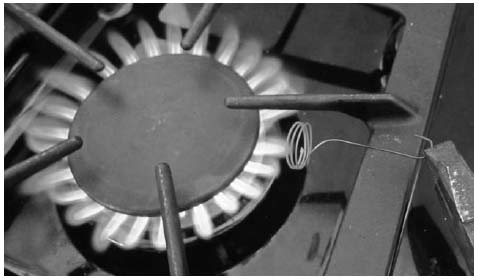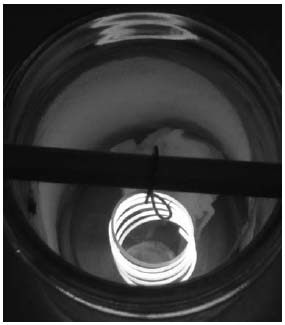Why Is Milk White? (27 page)
Read Why Is Milk White? Online
Authors: Alexa Coelho

An important part of a scientist's work goes a step beyond the scientific method. Discovering a new bit of knowledge is of little use to anyone but the discoverer unless it is published. And then the publication can lead to other scientists retesting the hypothesis to make sure the original work was done properly and without errors. It can also lead to alternative hypotheses to explain the data and the experimental results, leading to new hypotheses and tests to see what is really going on.
In chemistry, this general scientific approach to learning new information is used all the time. So chemists are scientists. But so are mechanics, judges, animal trainers, and parents. Anyone who uses the scientific method can be a scientist.
Chemistry deals with matter. Physics also deals with matterâits motion, energy, and force. There is an obvious overlap between the two, especially in areas such as quantum chemistry and physical chemistry.
You can do a lot of chemistry without thinking much about the underlying physics. Mixing hydrochloric acid and sodium hydroxide will always give you salt water. Understanding why they react is important, and it is based on physics, but once you know why, you can rise above the physics and use the rules of chemistry to build new molecules or analyze crime-scene data without using our understanding of particle physics.
Some physicists like to think that all of chemistry is physics, since physics determines everything that goes on in reactions between molecules. But that would be to ignore the value of higherlevel abstractions. A chemist can understand proteins as chains of amino acids, forming strings, sheets, and corkscrew shapes that interact to control the shape, and thus the function, of the protein. To try to understand protein synthesis by starting with quarks and photons would be to make it needlessly complicated. It would
be like trying to understand a hurricane through its individual air molecules. If what you need is a rain forecast, higher-level abstractions will get you there with a lot less trouble.
The parts of physics that are not chemistry are huge. All of high-energy physics, the study of what goes on inside nuclei, the study of gravity, and things like relativity are all physics.
Technology is about making and using tools. Sometimes the tools are physical things, and sometimes they are processes or systems that allow us to do something in a better way.
Chemists use many tools, so they use technology all the time. They use tools such as scales, spectrographs, gas chromatographs, mass spectrometers, computers, pH meters, and Bunsen burners. But they also use techniques such as titration, crystallization, chromatography, and flame tests, all of which are technologies, even if they don't use a particular tool.
Chemists are also at the forefront of tool design, helping design new materials for things like jet engines, surgical devices, lights, lasers, computer chips, and automobile engines.
Chemists are helping to develop new technologies all the time. New high-temperature superconductors are being made by chemists working with physicists. New kinds of rubber for car tires, new kinds of plastics for lightweight aircraft, biodegradable plastics for disposable eating utensils, and nanomaterials for electronics and medicine are just a few examples.
Chemists use mathematics. Sometimes they use simple arithmetic to balance chemical equations. For example, we know that burning hydrogen with oxygen makes water:

But that equation is wrong, since there is only one oxygen on the right side, but there were two on the left side. So we use arithmetic to balance the equation:

Chemists use simple mathematics to deal with ratios and proportions, units and dimensions, and simple statistics. They plot graphs of their observations and results.
Chemists also use more advanced mathematics to deal with rates of change in chemical reactions, to find maximums and minimums, or to determine other extremes or inflection points.
While mathematics is used a lot in chemistry, most of the mathematics is fairly simple. The mathematics in physics is generally more involved, and in physical chemistry you might find higher mathematics used more often than in many of the other branches of chemistry. The nature of the problem is usually what determines the tools needed to solve it.
You'd generally see a lot of water in use. Chemists are always washing up, diluting, dissolving, or cooling something with water.
Aside from that, the chemicals in use will depend on what the chemist is trying to do. In many chemistry labs a standard set of reagents is available, including acids, bases, indicators, solvents, oxidizers, and reducing agents.
A biochemical lab might have agar for making nutrient gels, various minerals for encouraging the growth of microbes under study, stains for DNA or for microscopic study, disinfectants, genetic material, and primers for DNA amplification. A polymer chemistry lab might have a variety of monomers, solvents, and catalysts. An atmospheric chemistry lab may have little or no use for chemicals in the lab at all, or it might have a wide variety of volatile compounds to study.
COPPER CATALYST
Adult
supervision
required
Materials
Protective goggles
Paper towel
Glass jar or similar glass container
1 tablespoon acetone (available at hardware stores)
1 foot of copper wire (available at hardware stores)
Pencil
Pliers or tongs
Gas kitchen stove
The catalytic converter used in cars with internal combustion engines uses platinum and palladium catalysts to combine unburned fuel with oxygen to produce carbon dioxide and water vapor. This prevents the unburned fuel from creating smog. At the same time, the catalysts break down nitrogen oxides that also contribute to air pollution.
The converter needs to be hot in order to work, but once it starts working, the reaction provides extra heat to keep the catalyst hot. It actually glows red hot in use.
In this project, you are going to perform a similar catalytic reaction, but instead of using expensive noble metals like platinum and palladium, you will use simple copper wire as the catalyst. The drawback to using copper is that it is only able to catalyze a small number of fuels, such as methanol and acetone. But acetone is easy to come by at your local hardware store.
Start by
putting on protective goggles.
Curl up a strip of paper towel use it to line the sides of a glass jar as shown.
Then drop in about a tablespoon of acetone. The paper towel ensures that a lot of acetone vapor stays in the jar. You also need approximately 1 foot of copper wire, bent into a hook on one end and coiled up on the other end as shown, and a pencil from which to hang the wire. Make sure the wire will fit nicely in the jar.
Since the catalyst needs to be hot for the reaction to happen, use pliers or tongs to hold the wire in the flame of a gas stove until it is red hot and glowing.
The last step is to hang the glowing copper coil from the pencil so that the coil hangs in the center of the jar.

The copper coil gets even hotter than it was before we put it in the jar, as the acetone vapor and oxygen combine on the
surface of the copper, releasing heat. There is no flame, since the vapor is not actually burning. It is hot, however, and the copper glows yellow and white. You can feel the heat rising from the jar if you put your hand over it.


The reaction will last as long as there is acetone vapor to consume. The tablespoon of acetone I used in this project lasted several minutes, and the coil glowed hot enough to read by in the dark.
Some aren't. Chemists have a sense of humor like everyone else. I think.
Most chemists I know have a lot of fun doing chemistry, and they got into chemistry because they were having fun. But most people take their work seriously, especially if it can change the world and improve people's lives.
If your job was to create new molecules to cure a disease or to understand how human activities are affecting the environment or to figure out how to clean up nuclear waste, you would want to do a good job. But if you were a comedian or a circus clown, you would still want to do a good job. Most people take their jobs seriously.
Chemists must also be very careful when they work, so as not to injure themselves or others and to make sure that the results they get are correct. In this regard they are similar to firefighters and accountants, soldiers and rocket scientists, and doctors and engineers. All of those people are serious about their work too.
Pharmacies deal with medicines, and most medical compounds are small organic molecules, such as aspirin or ethanol, or larger biological molecules, mostly proteins like insulin or prolactin. So a pharmacist is doing a fair bit of chemistry, in addition to biology, medicine, and retail sales.